Birds with red beaks are among the most amazing animals on the planet. They have a variety of shapes and hues that dazzle us with their beauty. In this article, we’ll introduce you to 16 of these gorgeous birds with scarlet bills. You’ll see vivid images and learn interesting facts about each of them. So, join us on a colorful adventure through the world of birds with ruby beaks.
Small Birds With Red Beaks Names Incl Description
1. Northern Cardinal

Scientific Name: Cardinalis cardinalis
Appearance
The Northern Cardinal is a strikingly beautiful bird. Males have bright red plumage, while females are a more subtle reddish-brown. Both genders share a distinct crest on their heads.
Size
These birds measure around 8 to 9 inches (20 to 23 cm) in length.
Weight
Northern Cardinals typically weigh between 1.5 to 1.7 ounces (42 to 48 grams).
Wingspan
Their wingspan ranges from 9.8 to 12.2 inches (25 to 31 cm).
Lifespan
In the wild, Northern Cardinals generally live for 3 to 5 years.
Behavior
They are known for their melodic songs and are often heard singing in the morning.
Habitat
Northern Cardinals prefer woodlands, gardens, and backyards in eastern North America.
Diet
Their diet primarily consists of seeds, fruits, and insects.
Location
You can find these birds in the eastern part of North America, from Canada to Mexico.
Fun Fact
Unlike many other species, Northern Cardinals mate for life and stay together throughout the year.
2. Wood Duck
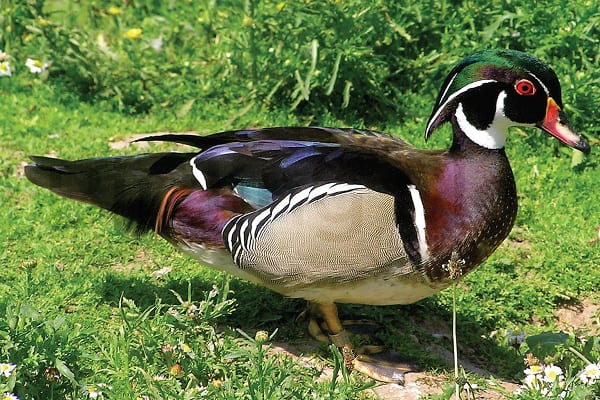
Scientific Name: Aix sponsa
Appearance
Wood Ducks are known for their vibrant, iridescent plumage, with distinctive markings on their heads.
Size
They measure approximately 19 to 21 inches (48 to 53 cm) in length.
Weight
Wood Ducks typically weigh between 1.3 to 1.4 pounds (600 to 635 grams).
Wingspan
Their wingspan ranges from 26 to 29 inches (66 to 74 cm).
Lifespan
In the wild, Wood Ducks can live up to 5 years.
Behavior
These ducks are excellent tree cavity nesters.
Habitat
They are commonly found in wooded swamps and ponds in North America.
Diet
Their diet includes aquatic plants, insects, and acorns.
Location
Wood Ducks can be spotted across North America, from Canada to the southern United States.
Fun Fact
Wood Ducks have sharp claws, which help them perch on tree branches.
Related Article: Small Birds with Long Beaks
3. Common Merganser

Scientific Name: Mergus merganser
Appearance
Common Mergansers are characterized by their sleek bodies, green heads, and bright red serrated bills.
Size
They measure around 25 to 28 inches (64 to 71 cm) in length.
Weight
Common Mergansers typically weigh between 2.5 to 3.3 pounds (1.1 to 1.5 kg).
Wingspan
Their wingspan ranges from 29 to 33 inches (74 to 84 cm).
Lifespan
In the wild, these birds can live up to 9 years.
Behavior
Common Mergansers are skilled divers, capable of staying submerged for long periods.
Habitat
They prefer freshwater lakes and rivers across North America.
Diet
Their diet primarily consists of fish and aquatic insects.
Location
Common Mergansers birds with red beaks can be found in North America, Europe, and Asia.
Fun Fact
These birds are known for their rapid wingbeats and sharp turns during flight.
4. Red-breasted merganser

Scientific Name: Mergus serrator
Appearance
Red-breasted mergansers have a distinctive red-brown head and a slender, serrated, bright red bill.
Size
They measure around 20 to 26 inches (51 to 66 cm) in length.
Weight
Red-breasted mergansers typically weigh between 1.3 to 2.2 pounds (590 to 1,000 grams).
Wingspan
Their wingspan ranges from 28 to 34 inches (71 to 86 cm).
Lifespan
In the wild, they live for about 9 to 11 years.
Behavior
These birds with red beaks are highly migratory, traveling long distances during the winter.
Habitat
They are commonly found in freshwater lakes, rivers, and coastal waters.
Diet
Red-breasted mergansers primarily feed on fish and crustaceans.
Location
You can spot them in North America, Europe, and Asia.
Fun Fact
These agile divers can swim underwater for over a minute while hunting for food.
Must Visit: Amazing Birds With Orange Beaks
5. American Oystercatcher
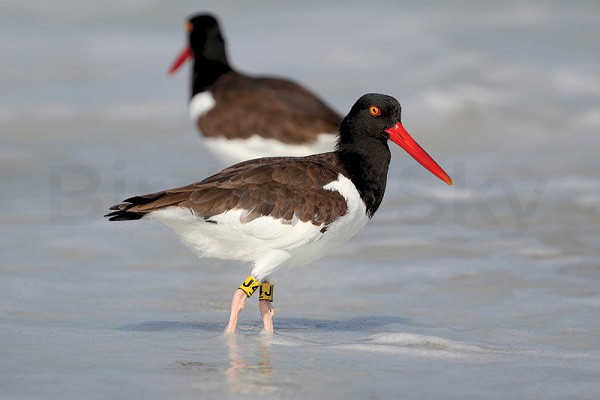
Scientific Name: Haematopus palliatus
Appearance
American Oystercatchers are large, striking birds with black and white plumage and a distinctive long, bright red bill.
Size
They measure around 16 to 19 inches (41 to 48 cm) in length.
Weight
American Oystercatchers typically weigh between 1.1 to 1.4 pounds (500 to 640 grams).
Wingspan
Their wingspan ranges from 29 to 35 inches (74 to 89 cm).
Lifespan
In the wild, they live for about 15 to 20 years.
Behavior
These birds are known for their distinctive vocal calls.
Habitat
They are often seen along coastlines, especially near estuaries and saltwater marshes.
Diet
Their diet primarily consists of bivalve mollusks, which they open with their strong bills.
Location
American Oystercatchers can be found along the coastlines of North and South America.
Fun Fact
These birds are monogamous and often return to the same breeding territory year after year.
6. Black Oystercatcher

Scientific Name: Haematopus bachmani
Appearance
Black Oystercatchers are entirely black with a bright red bill and striking yellow eyes.
Size
They measure around 15 to 18 inches (38 to 46 cm) in length.
Weight
Black Oystercatchers typically weigh between 1.1 to 1.8 pounds (500 to 820 grams).
Wingspan
Their wingspan ranges from 28 to 30 inches (71 to 76 cm).
Lifespan
In the wild, they live for about 15 to 25 years.
Behavior
These birds are highly territorial and defend their nesting sites vigorously.
Habitat
They are often found along rocky coastlines and offshore islands.
Diet
Their diet primarily consists of marine invertebrates and small fish.
Location
Black Oystercatchers can be found along the Pacific coastline of North America.
Fun Fact
Black Oystercatchers are known for their distinctive, high-pitched calls that echo along the coast.
7. White Ibis Birds with long red beaks
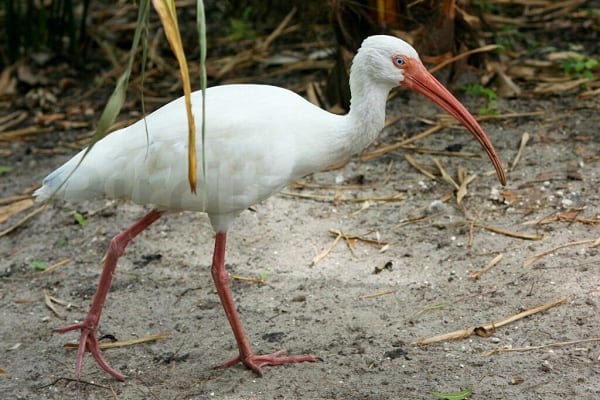
Scientific Name: Eudocimus albus
Appearance
White Ibises are large wading birds with all-white plumage and a long, curved red bill.
Size
They measure around 22 to 27 inches (56 to 69 cm) in length.
Weight
White Ibises typically weigh between 1.5 to 2.4 pounds (680 to 1,100 grams).
Wingspan
Their wingspan ranges from 36 to 41 inches (91 to 104 cm).
Lifespan
In the wild, they live for about 16 to 18 years.
Behavior
White Ibises are social birds often seen in large flocks.
Habitat
They are commonly found in marshes, swamps, and wetlands in the southeastern United States.
Diet
Their diet primarily consists of crustaceans, insects, and small fish.
Location
White Ibises are native to the southeastern United States.
Fun Fact
During the breeding season, their bills turn pink, adding a unique touch to their appearance.
Must Read: Birds With Long Beaks
8. Black Skimmer

Scientific Name: Rynchops niger
Appearance
Black Skimmers have black upperparts, white underparts, and a strikingly vibrant orange-red bill with a lower mandible longer than the upper.
Size
They measure around 16 to 20 inches (41 to 51 cm) in length.
Weight
Black Skimmers typically weigh between 5.1 to 10.2 ounces (145 to 290 grams).
Wingspan
Their wingspan ranges from 42 to 45 inches (107 to 114 cm).
Lifespan
In the wild, they live for about 20 to 25 years.
Behavior
Black Skimmers are known for their unique feeding technique of skimming the water’s surface with their lower mandibles.
Habitat
They are commonly found on sandy beaches, riverbanks, and estuaries.
Diet
Black Skimmers primarily feed on small fish and crustaceans.
Location
Black Skimmers can be found along the coasts of the Americas.
Fun Fact
Their striking bill is not only colorful but also highly adapted for catching prey in flight.
9. Laughing Gull
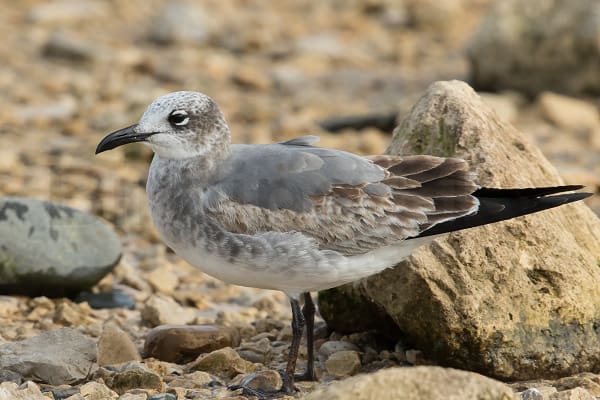
Scientific Name: Leucophaeus atricilla
Appearance
Laughing Gulls have a white head, neck, and underparts with a dark gray mantle and a distinct, slender, bright red bill.
Size
They measure around 14 to 16 inches (36 to 41 cm) in length.
Weight
Laughing Gulls typically weigh between 6.3 to 9.9 ounces (180 to 280 grams).
Wingspan
Their wingspan ranges from 32 to 35 inches (81 to 89 cm).
Lifespan
In the wild, they live for about 12 to 20 years.
Behavior
These gulls are known for their distinctive “laughing” calls.
Habitat
Laughing Gulls can be found along the Atlantic and Gulf coasts of the Americas.
Diet
Their diet primarily consists of fish, invertebrates, and scavenged food.
Location
They are commonly seen along coastal areas from North to South America.
Fun Fact
Laughing Gulls are highly opportunistic and are often seen stealing food from other birds.
10. Purple Gallinule

Scientific Name: Porphyrio martinica
Appearance
Purple Gallinules are striking birds with iridescent purple-blue plumage, a red bill, and yellow legs.
Size
They measure around 10 to 15 inches (25 to 38 cm) in length.
Weight
Purple Gallinules typically weigh between 4.2 to 6.3 ounces (120 to 180 grams).
Wingspan
Their wingspan ranges from 21 to 24 inches (53 to 61 cm).
Lifespan
In the wild, they live for about 5 to 7 years.
Behavior
These birds are known for their dainty walking on aquatic vegetation.
Habitat
Purple Gallinules are often found in freshwater marshes and wetlands in the southeastern United States.
Diet
Their diet primarily consists of plant material, insects, and small fish.
Location
Purple Gallinules are native to the southeastern United States.
Fun Fact
Their long toes and sturdy build enable them to walk on floating vegetation.
11. Common Tern

Scientific Name: Sterna hirundo
Appearance
Common Terns have a slender body, pale gray plumage, and a distinctive bright red bill with a black tip.
Size
They measure around 12 to 15 inches (30 to 38 cm) in length.
Weight
Common Terns typically weigh between 3.3 to 4.2 ounces (94 to 119 grams).
Wingspan
Their wingspan ranges from 29 to 31 inches (74 to 79 cm).
Lifespan
In the wild, they live for about 10 to 20 years.
Behavior
These birds with red beaks are known for their graceful aerial acrobatics while hunting for fish.
Habitat
Common Terns are often found along coastlines, especially in sandy or pebbly areas.
Diet
Their diet primarily consists of small fish.
Location
Common Terns are found across North America, Europe, and Asia.
Fun Fact
Common Terns are known for their synchronized feeding dives in large groups.
12. Caspian Tern
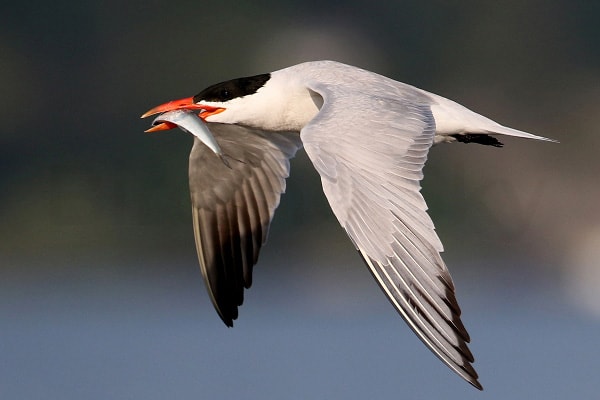
Scientific Name: Hydroprogne caspia
Appearance
Caspian Terns are the largest terns in the world, with black caps on their heads, white bodies, and vibrant red bills.
Size
They measure around 20 to 23 inches (51 to 58 cm) in length.
Weight
Caspian Terns typically weigh between 1.3 to 2.4 pounds (585 to 1,100 grams).
Wingspan
Their wingspan ranges from 47 to 53 inches (120 to 135 cm).
Lifespan
In the wild, they live for about 20 to 26 years.
Behavior
These birds with red beaks are skilled fishers, often diving from great heights to catch their prey.
Habitat
Caspian Terns are often found near large bodies of water, including lakes and coastal areas.
Diet
Their diet primarily consists of fish.
Location
Caspian Terns can be found worldwide, often near large bodies of water.
Fun Fact
Caspian Terns have a distinctive, loud, and harsh call often heard during their breeding season.
Do You Know: Red Peacocks Real or Fake
13. Common Gallinule
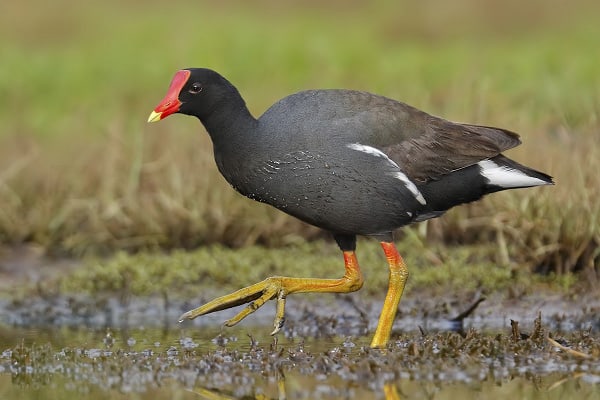
Scientific Name: Gallinula galeata
Appearance
Common Gallinules are medium-sized birds with dark plumage, a distinctive red bill, and a red shield on their foreheads.
Size
They measure around 12 to 15 inches (30 to 38 cm) in length.
Weight
Common Gallinules typically weigh between 3.3 to 9.9 ounces (94 to 280 grams).
Wingspan
Their wingspan ranges from 20 to 24 inches (51 to 61 cm).
Lifespan
In the wild, they live for about 5 to 10 years.
Behavior
Common Gallinules are known for their territorial and aggressive nature.
Habitat
They are often found in freshwater marshes, lakes, and ponds.
Diet
Their diet primarily consists of aquatic vegetation, insects, and small fish.
Location
Common Gallinules are found in the Americas, including North and South America.
Fun Fact
These birds have long toes and can walk on floating vegetation, which is helpful for foraging.
Other Birds with Red Beaks – Honorable Mentions
14. Broad-Billed Hummingbird
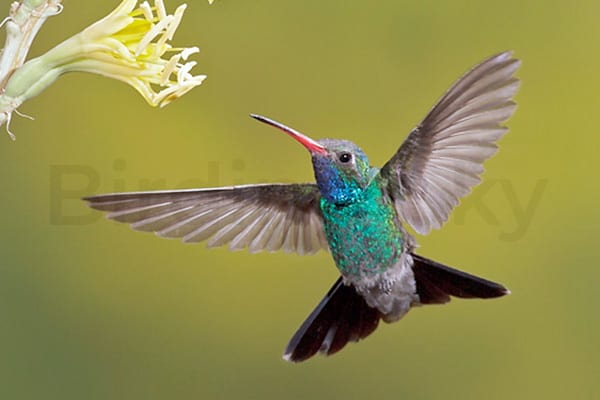
Scientific Name: Cynanthus latirostris
Appearance
Broad-billed hummingbirds have dazzling, iridescent green feathers, and their beaks are a striking shade of red.
Size
They measure around 3 to 4 inches (7.6 to 10 cm) in length.
Weight
Broad-billed hummingbirds typically weigh between 2.6 and 4.4 grams.
Wingspan
Their wingspan is about 4 to 4.5 inches (10 to 11.4 cm).
Lifespan
In the wild, they live for about 3 to 5 years.
Behavior
These tiny birds are known for their incredible agility in flight.
Habitat
Broad-billed hummingbirds are often found in arid and semi-arid regions of North America.
Diet
Their diet primarily consists of nectar from flowers and small insects.
Location
You can spot them in parts of the southwestern United States and Mexico.
Fun Fact
They are among the most colorful and vibrant birds in the hummingbird family.
15. Buff-Bellied Hummingbird

Scientific Name: Amazilia yucatanensis
Appearance
Buff-bellied hummingbirds are small with green feathers and a unique buff-colored belly, complemented by a red bill.
Size
They measure around 3.5 to 4.3 inches (9 to 11 cm) in length.
Weight
Buff-bellied hummingbirds typically weigh between 2.5 to 4 grams.
Wingspan
Their wingspan is approximately 4 to 4.5 inches (10 to 11.4 cm).
Lifespan
In the wild, they live for about 3 to 5 years.
Behavior
These birds with red beaks are known for their energetic and territorial nature.
Habitat
Buff-bellied hummingbirds are often found in coastal regions and tropical forests.
Diet
Their diet primarily consists of nectar from flowers and small insects.
Location
They can be found in the southern United States, Mexico, and Central America.
Fun Fact
Their buff-colored belly is a unique feature that sets them apart from other hummingbird species.
16. Black-Bellied Whistling Duck
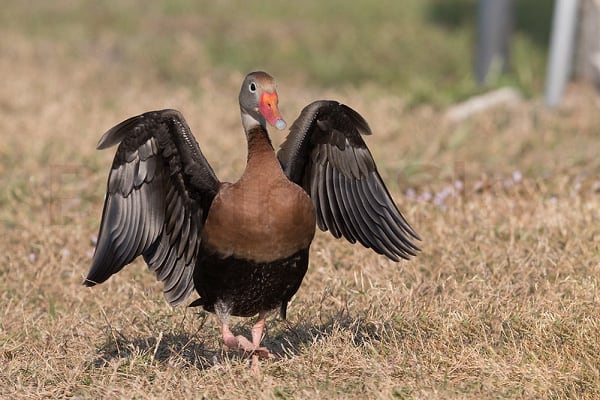
Scientific Name: Dendrocygna autumnalis
Appearance
Black-bellied whistling Ducks have striking plumage with a black belly, red bill, and distinctive white eye-ring.
Size
They measure around 17 to 22 inches (43 to 56 cm) in length.
Weight
Black-bellied whistling Ducks typically weigh between 1.1 to 1.5 pounds (500 to 680 grams).
Wingspan
Their wingspan is approximately 29 to 33 inches (74 to 84 cm).
Lifespan
In the wild, they live for about 4 to 8 years.
Behavior
These ducks are known for their distinctive whistling calls.
Habitat
Black-bellied whistling Ducks are often found in freshwater ponds, lakes, and marshes.
Diet
Their diet primarily consists of plants, seeds, and small invertebrates.
Location
They can be found in the southern United States, Mexico, and Central and South America.
Fun Fact
These ducks are excellent whistlers and are often heard before they are seen.
FAQ’s:
- What kind of bird has a red beak?
- Birds with red beaks can include species like the Northern Cardinal, the American Robin, and the Keel-billed Toucan, among others.
- Which bird has a red beak in India?
- In India, you can find birds like the Indian Pond Heron, which have red beaks.
- What is a large water bird with a red beak?
- The American White Pelican is a prime example of a large water bird with a distinctive red beak.
- What is a brown bird with a long red beak?
- The bird you may be referring to is the Keel-billed Toucan, known for its long, colorful, red and yellow beak.
- Why are birds’ beaks red?
- Birds can have red beaks for various reasons, such as mate attraction, thermoregulation, or signaling their health and vitality to potential partners.
Wrapping Up…
Birds with red beaks are more than just pretty to look at. They also have important roles in their environments. You can see how different they are by looking at the bright feathers of Northern Cardinals, the elegant flight of Caspian Terns, and the tiny miracles of hummingbirds. These birds with scarlet bills show how much variety there is among birds. As you learn more about where they live and what they do, you’ll admire them even more.
So, if you love birds or nature’s beauty, don’t miss these amazing birds with red beaks when you go outside. You’ll discover a colorful world of birds that will surprise you.
